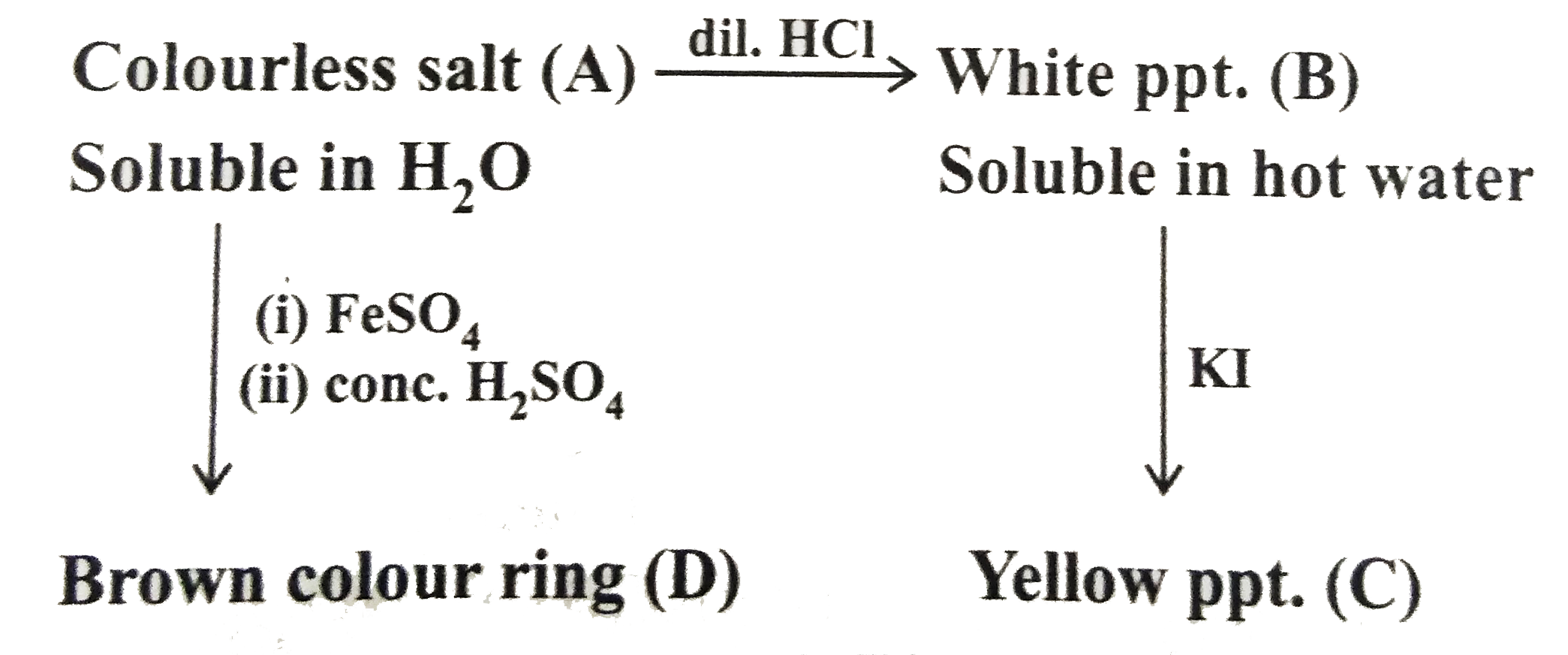Identify (A),(B),(C ) and (D) in the following :
Colourless salt (A) brawn fames intensifled on adding turnings
Aqueous solution (A) blue colour solution (B) and metal (C )
Aquneous soluytion (A) white ppt soluble in equeous forming (D)
(A) (B)
(C ) (D)
Topper's Solved these Questions
- QUALITATIVE INORGANIC SALT ANALYSISBOOK - CENGAGE CHEMISTRYCHAPTER - QUALITATIVE INORGANIC SALT ANALYSISEXERCISE - Solved Example
11 Videos
- QUALITATIVE INORGANIC SALT ANALYSISBOOK - CENGAGE CHEMISTRYCHAPTER - QUALITATIVE INORGANIC SALT ANALYSISEXERCISE - Exercises (Linked Comprehension)
68 Videos
- P-BLOCK GROUP 18 ELEMENTS - THE INERT GASESBOOK - CENGAGE CHEMISTRYCHAPTER - P-BLOCK GROUP 18 ELEMENTS - THE INERT GASESEXERCISE - Ex 5.1 (Objective)
14 Videos
- REDUCTION AND OXIDATION REACTION OF ORGANIC COMPOUNDSBOOK - CENGAGE CHEMISTRYCHAPTER - REDUCTION AND OXIDATION REACTION OF ORGANIC COMPOUNDSEXERCISE - SUBJECTIVE TYPE
3 Videos
Similar Questions
A white substance (A) reacts with dilute H2SO4 to produce a colourless suffocating gas (B) and a colourless solution (C )/ The reaction of gas (B) with potassium iodate and starch solution produce a blue colour solution. Aqueous Solution of (A) gives a white precipitate with BaCl2 solution which is soluble in dilute HCl. Addition of aqueous NH3 or NaOH to (C ) produced first a precipitate which dissolves in excess of the respective reagent to poduced a clear solution. Similarly addition of excess of potassium ferrocyanide to (C ) produced a precipitate (D) which also dissolves in aqeous NaOH giving a clear solution. Identify (A),(B),(C ) and (D ). Write the equation of the reactions involved.
View SolutionA white substance (A) reacts with dilute H2SO4 to produce a colourless suffocating gas (B) and a colourless solution (C )/ The reaction of gas (B) with potassium iodate and starch solution produce a blue colour solution. Aqueous Solution of (A) gives a white precipitate with BaCl2 solution which is soluble in dilute HCl. Addition of aqueous NH3 or NaOH to (C ) produced first a precipitate which dissolves in excess of the respective reagent to poduced a clear solution. Similarly addition of excess of potassium ferrocyanide to (C ) produced a precipitate (D) which also dissolves in aqeous NaOH giving a clear solution. Identify (A),(B),(C ) and (D ). Write the equation of the reactions involved.
View Solution
Knowledge Check
Aq. Suspension of a yellow substance (A)KI−−−−−−−→conc.solution colurless solution (B)NH4CI−−−−−−−−−−−→KOH solution added Brown ppt. Compound (A) is:
APbI2BAgICHgI2DHg2I2
Colourless salt (A)dil.HCI−−−−→ White ppt. (B)

Iidentify (A),(B),(C ) and (D)
View SolutionColourless salt (A)dil.HCI−−−−→ White ppt. (B)

Iidentify (A),(B),(C ) and (D)
View Solutiona.(A) +KBr→ yellow ppt . (B)
(A) +conc.H2SO4Δ−−→ brown vapours intensifield with cu- turnings.
(B) dissolves in lypo forming a soluble complex (C ) what are (A),(B) and (C ) and explain their reactions ?
b. SO2−3 and SO2−4 both give while ppt with BaCI2 solution .How is SO2−3 detected in presence of SO2−4?
c. Na2B4O7.10H2O+conc.H2SO4Δ−−→(A)CH2OHΔ−−−−−→(B) idenity (A) and (B)
d. (A) +diiH2SO4Δ−−→gas(B)
Gas (B) turns K2Cr2O7/HΘ solution green Aq solution of (A) +BaCI2→ while ppt .(C )
Filltrate after removing (C) +Br2 water rarr while ppt dissolve in qammon ium acetate solution Example.
View Solutiona.(A) +KBr→ yellow ppt . (B)
(A) +conc.H2SO4Δ−−→ brown vapours intensifield with cu- turnings.
(B) dissolves in lypo forming a soluble complex (C ) what are (A),(B) and (C ) and explain their reactions ?
b. SO2−3 and SO2−4 both give while ppt with BaCI2 solution .How is SO2−3 detected in presence of SO2−4?
c. Na2B4O7.10H2O+conc.H2SO4Δ−−→(A)CH2OHΔ−−−−−→(B) idenity (A) and (B)
d. (A) +diiH2SO4Δ−−→gas(B)
Gas (B) turns K2Cr2O7/HΘ solution green Aq solution of (A) +BaCI2→ while ppt .(C )
Filltrate after removing (C) +Br2 water rarr while ppt dissolve in qammon ium acetate solution Example.
View SolutionA balck coloured compound (A) on reaction with dilute H2SO4 gives a gas (B) which on passing in a solution of an acid (C ) gives a white turbidity (D). Gas (B ) when passed in an acidified solution of a compound (E ) gives a precipitate (F) soluble in dil HNO4 . After boiling this solution when an excess of NH4OH is added, a blue coloured compound (G) is formed. To this solution on addition of acetic acid and aqueous K4[Fe(CN)6] a chocolate precipitate (H) is obtained. On addition of an aqueous solution of BaCl2 to an aqueous solution of (E), a white precipitate insolution in HNO3 is obtained. Identify (A) to (H).
View SolutionIdentify (A),(B),(C ) and (D) and example reactions .
(A) (green coloured salt) +K2Cr2O7+concH2SO4Δ−−→(B)
(B) (redidish brown gas) + NaOH→(C)
(C ) +(CH3COO)2Pb→(D)(yellow ppt)
(A)+NaOH+Br2waterΔ−−→(C)
(C ) +(CH3COO)2PbΔ−−→(D)
View SolutionIdentify A, B, C, D and E.
A white substance (A) reacts with dilute H2SO4 to produce a colourless gas (B) and a colourless solution (C).The reaction between (B) and acidified K2Cr2O7 solution produces a green solution and a slightly coloured precipitate (D).The substance (D) burns in air to produce a gas (E) which reacts with (B) to yield (D) and a colourless liquid. Anhydrous copper sulphate is turned blue on addition of this colouless liquid.Addition of aqueous NH3 or NaOH to (C) produces first a precipitate
View Solution
